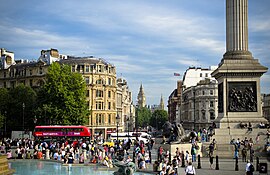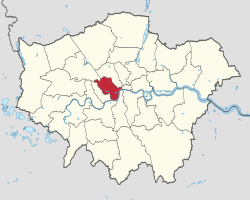
Back City of Westminster Afrikaans مدينة وستمنستر Arabic مدينة ويستمينستر ARZ Ciudá de Westminster AST Vestminster (London borosu) Azerbaijani شهر وستمینستر AZB Вэстмінстэр (бора Лондана) Byelorussian Ўэстмінстэр BE-X-OLD Уестминстър (район в Лондон) Bulgarian Ciutat de Westminster Catalan
City of Westminster | |
|---|---|
London borough and city | |
 Trafalgar Square, an open plaza in the city | |
 Westminster shown within Greater London | |
| Coordinates: 51°30′44″N 00°09′48″W / 51.51222°N 0.16333°W | |
| Sovereign state | United Kingdom |
| Country | England |
| Region | London |
| Ceremonial county | Greater London |
| Created | 1 April 1965 |
| Admin HQ | City Hall, Victoria Street |
| Government | |
| • Type | London borough council |
| • Body | Westminster City Council |
| • London Assembly | Tony Devenish (Conservative) |
| • MPs |
|
| Area | |
| • Total | 8.29 sq mi (21.48 km2) |
| • Rank | 288th (of 296) |
| Population (2022) | |
| • Total | 211,365 |
| • Rank | 92nd (of 296) |
| • Density | 25,000/sq mi (9,800/km2) |
| Time zone | UTC (GMT) |
| • Summer (DST) | UTC+1 (BST) |
| Postcodes | |
| Area code | 020 |
| ISO 3166 code | GB-WSM |
| ONS code | 00BK |
| GSS code | E09000033 |
| Police | Metropolitan Police |
| Website | www.westminster.gov.uk |
The City of Westminster is a London borough with city status in Greater London, England. It is the site of the United Kingdom's Houses of Parliament and much of the British government. It contains a large part of central London, including most of the West End, such as the major shopping areas around Oxford Street, Regent Street, Piccadilly and Bond Street, and the entertainment district of Soho. Many London landmarks are within the borough, including Buckingham Palace, Westminster Abbey, Whitehall, Westminster Cathedral, 10 Downing Street, and Trafalgar Square.
The borough also has a number of major parks and open spaces, including Hyde Park, Green Park and most of Regent's Park. Away from central London the borough also includes various inner suburbs, including St John's Wood, Maida Vale, Bayswater, Belgravia and Pimlico. The borough had a population of 204,300 at the 2021 census.

The original settlement of Westminster was historically a separate urban area to the west of London, growing up around the minster church of Westminster Abbey. Westminster was an important centre of royal authority from Saxon times, and was declared a city in 1540. It was gradually absorbed into the urban area of London, but London's official city boundaries remained unchanged, covering just the area called the City of London, broadly corresponding to the medieval walled city. From the 19th century some metropolis-wide administrative bodies were introduced. The County of London was created in 1889, replaced in 1965 by the larger administrative area of Greater London, which since 2000 has been led by the Mayor of London. The cities of London and Westminster retain their separate city statuses despite having long been part of the same urban area.
The modern borough was created in 1965 as part of the same reforms which created Greater London, covering the area of the three former metropolitan boroughs of Westminster, Paddington and St Marylebone. The local authority is Westminster City Council. To the east, Westminster borders the City of London, with the boundary marked by Temple Bar. Other neighbouring boroughs (anti-clockwise from north-east) are Camden, Brent, Kensington and Chelsea, Wandsworth and Lambeth, the latter two being separated from Westminster by the River Thames. Charing Cross in Westminster is the notional centre of London, being the point from which distances from London are measured.
© MMXXIII Rich X Search. We shall prevail. All rights reserved. Rich X Search

